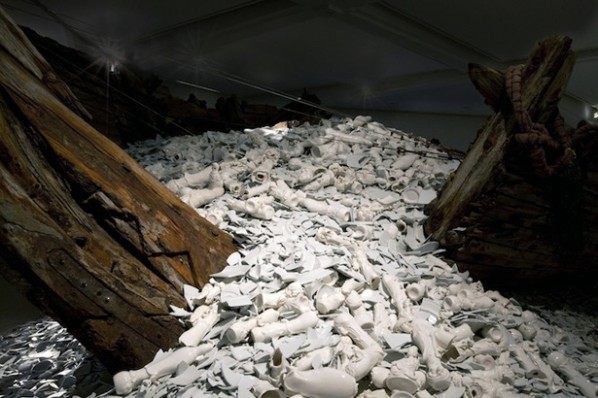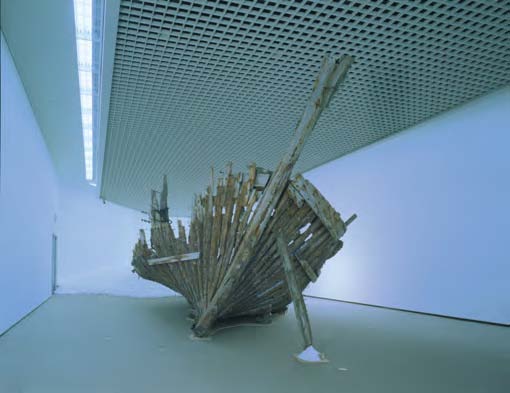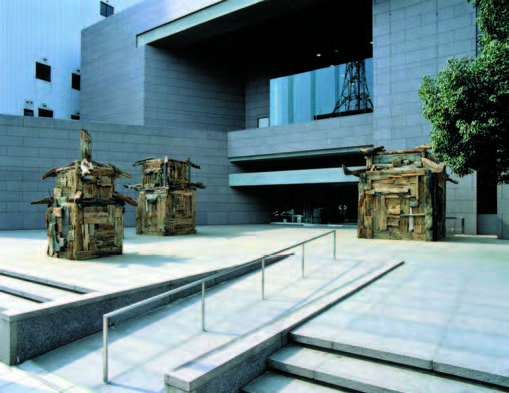
Cai, Iwaki, and the story, 2003. Ink on paper, 33.02 x 48.26 cm. (13 x 19 in). Collection of the artist
Faurschou Foundation will open on Thursday, September 6, 2012 with A Clan of Boats, the inaugural solo exhibition by artist Cai Guo-Qiang. The exhibition includes a series of newly commissioned gunpowder drawings inspired by Denmark’s nature, culture, and history. It will also highlight Reflection—A Gift from Iwaki (2004), part of the foundation’s collection, as the centerpiece. In the afternoon of the opening day, the artist will present his famed outdoor explosion project. This will mark Cai’s first one-man show in Scandinavia since 1997, when Louisiana Museum of Modern Art in Humleb?k, Denmark presented his solo exhibition Cai Guo-Qiang: Flying Dragon in the Heavens.

Reflection - A Gift from Iwaki (detail), Musée d'Art moderne et d'Art contemporain, Nice, France, 2010.
Cai and his studio team will work closely with local volunteers in Copenhagen to create his signature gunpowder drawings. The drawings will feature Danish natural history, nautical culture, and the artistry in their shipbuilding traditions. Open to public from August 25 to September 2, the event allows audience members to see how the artist works with such an extraordinary medium.
The outdoor explosion project will take place at 5 P.M. on September 6. A small, traditional Danish boat, with a layer of paper mounted on the exterior, will be hung over the plaza outside the foundation. Three thousand mini rockets will pierce through the hull, pointing outwards. Once ignited, the mini rockets will set off, looking as if the boat is fanning its wings. When the explosion concludes, the three-meter long vessel will be left with scorch marks by gunpowder, becoming a three-dimensional gunpowder drawing. It will then be displayed with the rest of the exhibition indoors, fostering a new direction in the artist’s ongoing exploration of the gunpowder medium and the genre of painting. As part of the exhibition opening, there will be an artist lecture/panel discussion on September 7, and a trip organized for overseas guests to the Lousiana Museum of Modern Art, about 45 minutes north of Copenhagen. A full-color catalogue will accompany the exhibition, with an essay by art critic Karen Smith, an interview from curator Hans Ulrich Obrist, and a recount of his fascination with boats since his youth along with descriptions of all boat-related works throughout his artistic journey from the artist himself.
About Reflection–A Gift from Iwaki
In 2004, the large-scale installation made its debut in the Arthur M. Sackler and Freer Gallery of Art: the National Museum of Asian Art at the Smithsonian Institution in Washington D.C.. The work was inspired by Cai’s friendship with the people of Iwaki, a small coastal city in Fukushima prefecture in Northeast Japan, where Cai completed a residency from 1993 to 1994. The people of Iwaki provided Cai tremendous support in the early years of his career when he lived in Japan. Together they excavated an old wooden fishing boat beached on the shores of Iwaki. This boat was then transformed into two works:
 Kaikou—The Keel (Returning Light—The Dragon Bone), 1994. Excavated fishing boat, salt, and fish, dimensions variable. Boat: 500 x 550 x 1,350 cm. Collection of City of Iwaki, Japan / Photo by Kazuo Ono, courtesy Cai Studio
Kaikou—The Keel (Returning Light—The Dragon Bone), 1994. Excavated fishing boat, salt, and fish, dimensions variable. Boat: 500 x 550 x 1,350 cm. Collection of City of Iwaki, Japan / Photo by Kazuo Ono, courtesy Cai Studio
Kaikou—The Keel (Returning Light—The Dragon Bone), 1994. Excavated fishing boat, salt, and fish, dimensions variable. Boat: 500 x 550 x 1,350 cm. Collection of City of Iwaki, Japan / Photo by Kazuo Ono, courtesy Cai Studio
 San Jō Tower , 1994. Salvaged wood from a sunken boat, dimensions variable. Collection of Iwaki City Art Museum, Iwaki
San Jō Tower , 1994. Salvaged wood from a sunken boat, dimensions variable. Collection of Iwaki City Art Museum, Iwaki
Photo by Kazuo Ono, courtesy Cai Studio
San Jō Tower , 1994. Salvaged wood from a sunken boat, dimensions variable. Collection of Iwaki City Art Museum, Iwaki
Photo by Kazuo Ono, courtesy Cai Studio
During the 2011 Great East Japan Earthquake, Iwaki was hit hard by the earthquake and tsunami. The group of Iwaki friends devoted time and effort to disaster relief, and Cai donated proceeds from the charity auction of a gunpowder drawing to the Iwaki friends. They used the funds from the auction to plant new cherry blossom trees in the aftermath of the unfortunate events, commemorating the catastrophe and expressing their lament to future generations. At the same time, the trees will also display their undying affection for their homeland as everyone rebuilds their lives together.
About Faurschou Foundation
In 2011, after 25 years at St. Strandstr?de, Luise and Jens Faurschou decided to transform Galleri Faurschou into Faurschou Foundation. They now operate two exhibition spaces for international contemporary art: Pakhus 53 in Frihavnen (Free Port, Copenhagen), and the existing location in 798 Art District in Beijing, China. Both exhibition spaces will be free and open to the public. Over the years, the Faurschous have assembled a notable international collection, and are planning future exhibitions with some of the world's foremost contemporary artists, curators, museums, and galleries. The Faurschou Foundation is a platform dedicated to the creation of new works and is committed to presenting thought-provoking contemporary art to the public.
Courtesy of Cai Studio and Faurschou Foundation, for further information please visit www.caiguoqiang.com?or www.faurschou.com.




























